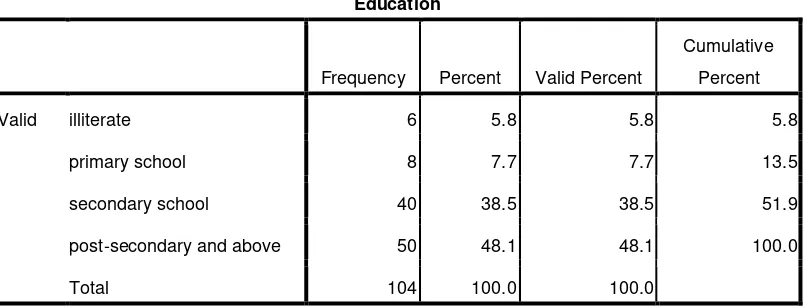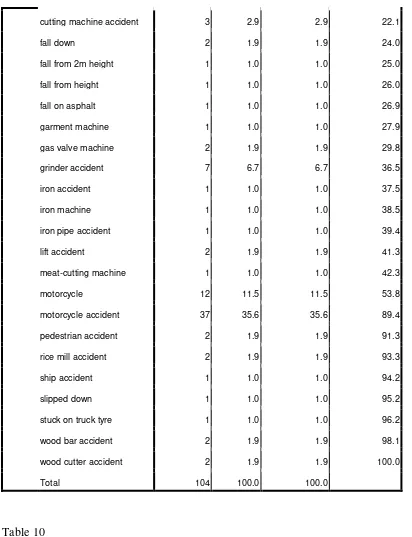Profile of Hand Injury from Januari
–
December 2013
in Sanglah General Hospital
Descriptive Study
dr. Agus Eka Wiradiputra
dr. A.A. Gede Yuda Asmara, SpOT
PROGRAM PENDIDIKAN DOKTER SPESIALIS I
BAGIAN/SMF ORTHOPAEDI DAN TRAUMATOLOGI
UNIVERSITAS UDAYANA
Profile of Hand Injury from Januari
–
December 2013
in Sanglah General Hospital
Descriptive Study
Agus Eka Wiradiputra*AA Gede Yuda Asmara**
*Resident of Orthopedic and Trauma, Faculty of Medicine Udayana University, Sanglah Hospital
Profile of Hand Injury from Januari
–
December 2013
in Sanglah General Hospital
Background
Injuries to the hand can pose a challenge for the emergency physician. These injuries are not
life threatening, however, the complexity of the area can pose many diagnostic and treatment
dilemmas. The anatomy of the hand is complex, which allows for the dexterity, strength, and
adaptability of the most functional aspect of the musculoskeletal system.
Twenty percent of patients attending Accident and Emergency Departments have hand
injuries, equating to more than 1.36 million attendances for hand injuries in the UK each
year. One in five of these injuries (271,000) require specialist care, and 71,000 patients
require surgery. These estimates are consistent with the annual incidence of hand fractures at
all ages of 3.6 per 1000 in British Columbia, Canada and the UK incidence for adults and
children of 1.8 and 2.6 per 1000 respectively.
Hand injuries predominantly affect the young working population and are a major source of
disability, causing significant costs to individuals and society through time away from work.
Improvements in health and safety practices and legislation have reduced the incidence of
mangling hand injuries in developed countries, but these injuries still occur and require
urgent treatment that may involve many hours in the operating theatre.
The evaluation and management of injuries to this area can be time consuming and pose a
significant medicolegal risk to the emergency physician. Improperly diagnosed and managed
injuries can lead to chronic pain, inability to perform activities of daily living, and even
seemingly minor injuries can lead to missed work causing a significant cost to the individual
and society.
Aim
To provide an analysis of recent hand injuries in Sanglah Hospital from Januari – December
2013, focussing in particular on presentations to emergency departments and admissions to
Benefit
Knowledge of hand injury profile in Sanglah Hospital 2011-2013 can help clinician in
designing a better diagnostic studies and treatment plans that can used to treat patients
effectively and minimize their exposure to risk. Also to decrease the prevalence of hand
injury due to increase of community awareness
Research Design
The research design is Descriptive Retrospective
Location and Time of Research
Sanglah General Hospital, January – December 2014
Data Source
Secondary data from patient medical record that came to emergency department of Sanglah
General Hospital.
Instrument of Research
Tabulation table including patient identity, medical record number, clinical notes, X-rays, and
Procedure of Research
Schema 1. Research Procedure METHODS
A review was made of admitted patients of hand injuries in our Emergency Department from
January-December 2013. We analyze 102 patient with variety demographic pattern,
mechanism of injury, type of injury and treatment was made to get the different aspects of
hand injuries in these study
We described the injury description from clinical photographs, x rays, and operative notes.
Patients with severe injuries had amputations of part or whole of the hand, which led to
terminalization operations in many cases and to severe disability and stiffness. Hand injuries
of the hand were treated with both operatif and nonoperatif procedure depending on the Data Collection from Patient
Medical Record
Data Tabulation
Data Entry to SPSS 17
Descriptive Analysis
extent of the injury, which was highly variable. The primary aim of management was
maximal preservation of function
RESULT
We identified that male sustain hand injuries more than female (87,5%,:12,5%). From the age
variables, more affected population in 20-30 years old (32,7%). Hand injury also common at
people with education level post secondary and above (48,1%), married people (65,4%),
work as construction 36,5 % and low socioeconomic status (79,8%). High energy
mechanism of injury (96,2%) is the most cause of hand injuries. Nature of injury seem more
cause by motorcycle accident 35,6%. Fracture are most common injury tipe 54,8% and
surgical treatment more often done (72,1%) in Sanglah General Hospital from January 2013
until December 2013. All of these data tabulation show at at table 1-11
DISCUSSION
Most of the victims of hand injury were males (87,5%), 32,7% aged 21 to 30 years, 65,4%
were married, 48,1% were post secondary and above education level. This indicates that
young, males are particularly prone to injuries. Males are more likely to perform hard labour
and are therefore at increased risk of injuries at work. Young and illiterate subjects are
usually less likely to be familiar with the jobs nature and could be more reckless. Thus,
having educated workers with a sense of responsibility about their job appears important to
preventing work-related injuries. Our data shown different result to prior study.
The Royal Hospital for Sick Children’s (Glasgow) Accident and Emergency Department sees
fingertip injuries which account for 1.8% of its workload. In the other research, The National
Institute for Occupational Safety and Health in the United States conducted a survey across
multiple emergency departments in 1982, and estimated occupational finger injuries to
account for 25.7% of its workload. Our study result nearly similar that show 35,6% hand
injuries suffered for construction working people, 26% student, 18.3% agriculture and 20.2%
unclassified. This is probably due to the tasks being undertaken and the equipment being
used which has the potential to exert large forces directly or indirectly to the hand and wrist.
Hand injury in our study report 79,8% case affect low income people. Low-income families
living in poor environmental conditions could be affected physically and psychologically,
are at greater risk of occupational hand injuries, partly because they usually have more
physically demanding jobs, poorer health status, and are more likely to be smokers and/ or
alcohol dependent.
In studies conducted around the world, equipment malfunction and equipment or jobs that the
workers were not used to were common risk factors for injury in the workplace. Adequate
protective equipments such as protective gloves are also regulations that should be enforced.
Same result for our study that show grinder accident (6,7%) happen more then the other type
injury of worker exclude motorcycle accident.
Nature of disease seem more cause by motorcycle accident 35,6%. Fracture are most
common injury tipe 54,8% and surgical treatment more often done (72,1%). Some injury
episodes will result in the injured person being recorded in more than one data set, but many
injured persons will only be recorded in one or no data sets. The extent of overlap between
the various data sources is not known. However, it is clear that to gain a full appreciation of
the extent of hand injury in the community, information will be required from several
different sources. In addition, one of the keys to developing effective interventions aimed at
preventing injury is having a good understanding of the characteristics of the injured persons,
their injuries, and the circumstances in which the injuries occurred. Since each data source
probably has characteristic injuries with characteristic injury circumstances, it is necessary to
examine information from a range of data sources in order to plan appropriate interventions.
CONCLUSION
Hand injuries have previously been shown to be an important reason for presentation at
emergency departments. Fingertip injuries should not be taken lightly as they can result in
significant morbidity if poorly treated. Functional as well as aesthetic considerations have to
be taken into account when treating fingertip injuries. Most fingertip injuries can be treated
by the family or emergency physician, but there are some conditions that require referral to
hand surgeons for optimal management.
It is important to choose the selective treatment of the hand injury and should be considered
with characteristic of the patients. We found similarities as well as difference in result
compared to previous studies. This study add our knowledge about hand injuries in balinesse
References
1. Schoffl, Volker. Tendon Injuries of The Hand. Baishideng 2012.
2. C J, Yeo. Finger Tip Injuries. Singapore 2010.
3. Monteleone, Guy. Hand and Finger Injuries. West Virginia 2010.
4. Abraham, Michael K. The Emergent Evaluation and Treatment of Hand and Wrist
Injuries. Baltimore 2010.
5. Garg, Rajesh. Epidemiology of Occupational Hand Injury in Hong Kong. Hong Kong
2012.
6. Brennen, Michael. Hand Surgery in The UK. England 2007.
7. Driscoll, Tim. Work-related Hand and Wrist Injurie in Australia. Australia 2008.
Table 1
Age
Frequency Percent Valid Percent
Cumulative
Frequency Percent Valid Percent
Cumulative
Frequency Percent Valid Percent
Table 4
Marital
Frequency Percent Valid Percent
Cumulative
Frequency Percent Valid Percent
Cumulative
Frequency Percent Valid Percent
Cumulative
Frequency Percent Valid Percent
Cumulative
Percent
Valid low energy 4 3.8 3.8 3.8
Velocity
Frequency Percent Valid Percent
Cumulative
Frequency Percent Valid Percent
Cumulative
Frequency Percent Valid Percent
cutting machine accident 3 2.9 2.9 22.1
Frequency Percent Valid Percent
Cumulative
Percent
Valid open injury 69 66.3 66.3 66.3
close injury 35 33.7 33.7 100.0
Table 11
Treatment
Frequency Percent Valid Percent
Cumulative
Percent
Valid conservative 29 27.9 27.9 27.9
surgical 75 72.1 72.1 100.0




